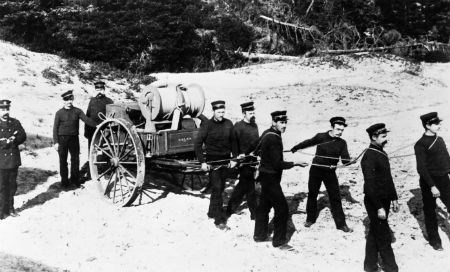
The BeginningThe first lifesavers on the Outer Banks were the original European settlers. They were severely isolated and lived an extremely difficult, hardscrabble life. Their very existence was dependent upon helping each other, so it was only natural that when a shipwreck occurred within their sight that they would go to help. No records were kept of these activities, so we have no hard data. But these were clearly the first Outer Banks “volunteer lifesavers.”
Life-Saving Service on the Outer BanksThe first Outer Banks Life-Saving Service (LSS) stations were built and manned in 1874. They were, from north to south, Jones Hill (later with the more familiar name “Currituck Beach”), Caffeys Inlet, Kitty Hawk, Nags Head, Bodie island (renamed “Oregon Inlet”), Chicamacomico (now village of Rodanthe) and Little Kinnakeet (just north of today’s village of Avon). In 1878, eleven more stations were added. These included the now famous Kill Devil Hills station, which assisted the Wright brothers, and the Hatteras Inlet station. Still more were added, eventually totaling 29, averaging about six miles apart on the NC outer coast from the Virginia line (Wash Woods LSS – 1878), to the South Carolina line (Oak Island LSS- 1886). In 1915, all these became Coast Guard stations. US Life-Saving Service in Cape Hatteras National SeashoreUnited States Life-Saving Service stations on Bodie, Hatteras and Ocracoke Islands – includes the area in 1953 which became the Cape Hatteras National Seashore – were Bodie Island, Oregon Inlet, Pea Island, New Inlet, Chicamacomico, Gull Shoal, Little Kinnakeet, Big Kinnakeet, Creeds Hill, Cape Hatteras, Durants, Hatteras Inlet and Ocracoke. Two highly significant United States Life-Saving Service complexes of those stations still exist that are properties of the National Park Service, Cape Hatteras National Seashore. They are Bodie Island Life-saving Station and Little Kinnakeet Life-saving Station. Two other nearby stations, the Oregon Inlet Life Saving Station and the Chicamacomico Life Saving Station are located outside of National Seashore boundaries but can be visited. |
Last updated: May 21, 2024
